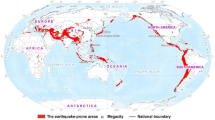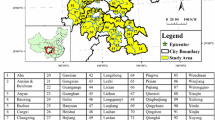Abstract
China suffers severe earthquake disasters along the Pacific Rim. Rapid urbanization, population growth and economic production have dramatically changed China both spatially and temporally. Exposure has increased rapidly compared with hazards and vulnerability, and exposure has increased earthquake risks more than hazards and vulnerability. Based on county-level data, this paper emphasizes the rising exposure of high earthquake risk regions (HERRs) by analyzing the concentration of population and GDP in HERRs. The results reveal three findings. (1) Population and GDP transferred to HERRs from 2000 to 2010. The vast majority of the population growth (88%) and GDP growth (63.8%) occurred in HERRs, and 16.4% of the population growth and 16.4% of the GDP growth occurred in counties where an earthquake of M 7.5 + may take place. (2) The shift of population and GDP growth in East China was more dramatic than that in West, Central and Northeast China. Overall, 56.8% of the population growth and 38.0% of the GDP growth occurred in HERRs in East China. (3) The Theil index showed that the internal population distribution for each region was also distinct. East China had the largest population growth in HERRs but had the most separation among the regions in China. In both 2010 and 2000, East China had the largest internal Theil index. The population and GDP were concentrated in the places with high earthquake risks, especially in the developed areas of East China. And East China had the most internal inequality. Increasing earthquake risks are a challenges for the country’s social and economic development.



Similar content being viewed by others
References
Bouwer, L. M., Crompton, R. P., Faust, E., et al. (2007). Confronting disaster losses. Science, 318, 753.
Bureau of Economic Analysis, U.S Department of Commerce. (2009). Concepts and methods of the U.S. national income and product accounts. Available from http://www.bea.gov/national/pdf/NIPAhandbookch1-4.pdf
Chen, Q. F., & Chen, L. (1997). Evaluation methods of earthquake damage prediction: based on GDP and population. Acta Seismologica Sinica, 19(6), 640–649. (In Chinese).
Chen, Y., Chen, Q. F., & Chen, L. (1997). World wide seismic risk analysis based on limited data: First international earthquake and megacities workshop. Seeheim, Germination, 1997, 290.
Chen, Y., Chen, Q. F., & Chen, L. (2001). Vulnerability analysis in earthquake loss estimate. Natural Hazards, 23(2), 349–364.
Cheng, Q.L., Xu, Z., Zeng, X., et al. (2016). Building seismic damage prediction of Tangshan City, based on nonlinear time-history analysis of urban buildings. In China Civil Engineering Society, Proceedings of the 2016 national conference of China Civil Engineering Society (pp. 319–329). Beijing: China City Press (in Chinese)
Cutter, S. L. (1996). Vulnerability to environmental hazards. Progress in Human Geography, 20(4), 529–539.
Fu, J. Y., Jiang, D., & Huang, Y. H. (2014). 1 km grid population dataset of China (2005, 2010). Acta Geographica Sinica, 69(sup.), 136–139.
Gao, M. T. (2016). The new seismic hazard map and social-economy development in China. City and Disaster Reduction, 3, 1–5. (in Chinese).
Gao, M. T., Wu, G. C., Wu, X. Y., & Lang, C. (2014). From the perspective of social risk theory: the role of the earthquake prevention and disaster reduction system in the National Significant Seismic Monitoring and Protection Regions. Earthquake Research in China, 30(3), 300–305. (in Chinese with English abstract).
He, C. Y., Huang, Q. X., Dou, Y. Y., et al. (2016). The population in China’s earthquake-prone areas has increased by over 32 million along with rapid urbanization. Environmental Research Letters, 11(7), 074028.
Holzer, T. L., & Savage, J. C. (2013). Global earthquake fatalities and population. Earthquake Spectra, 29(1), 155–175.
Huang, Y. H., Jiang, D., & Fu, J. Y. (2014). 1 km grid GDP dataset of China (2005, 2010). Acta Geographica Sinica, 69(sup.), 140–143.
Lang, C., Wu, G. C., & Gao, M. T. (2014). The seismic hazard diversity of the National Significant Seismic Monitoring and Protection Regions and the suggestions of category-management based on local seismic hazard characteristics. Earthquake Research in China, 30(3), 324–329. (In Chinese with English abstract).
Liu, H., Xu, Z. C., Wu, S. H., et al. (2012). GIS-based analysis of earthquake disaster population risk in China. Progress in Geography, 31(3), 368–374. (In Chinese with English abstract).
Lu, X. Z., & Guan, H. (2017). Earthquake disaster simulation of civil infrastructures. Beijing: Springer and Science Press.
National Bureau of Statistics of China (2000) The 2000 population census of the People’s Republic of China. Available from http://www.stats.gov.cn/tjsj/pcsj/rkpc/5rp/index.htm (in Chinese).
National Bureau of Statistics of China. (2001a). China statistical yearbook for regional economy 2001. Beijing: China Statistics Press.
National Bureau of Statistics of China. (2001b). China city statistical yearbook 2001. Beijing: China Statistics Press.
National Bureau of Statistics of China (2010a) The 2010 population census of the People’s Republic of China. Available from http://www.stats.gov.cn/english/Statisticaldata/CensusData/rkpc2010/indexch.htm.
National Bureau of Statistics of China (2010b) Instructions for population census questionnaires. Available from http://www.stats.gov.cn/tjsj/ndsj/2015/indexeh.htm.
National Bureau of Statistics of China. (2011a). China statistical yearbook for regional economy 2011. Beijing: China Statistics Press.
National Bureau of Statistics of China. (2011b). China city statistical yearbook 2011. Beijing: China Statistics Press.
National Bureau of Statistics of China (2015) China statistical yearbook 2015. China Statistics Pressures, Beijing. Available from http://www.stats.gov.cn/tjsj/ndsj/2015/indexeh.htm
Nie, C. J., Yang, L. S., & Li, H. R. (2012). Macro assessment of seismic population vulnerability in China. Progress in Geography, 31(3), 375–382. (In Chinese with English abstract).
Perroux F (1955) Note sur la notion de poles croissance. Economic Appliquee, 1&2, 307–320 (Translated by Mette Monsted, (1974)).
Qi, W. H., Su, G. W., Zhang, S. L., et al. (2012). Study on the changes of vulnerability and loss risk of buildings from seismic disaster in the process of urbanization—A case study of Tangshan area. Seismology and Geology, 34(4), 820–834. (In Chinese with English abstract).
Serje, J. (2010). Preliminary extensive risk analysis for the Global Assessment Report 2011. Geneva: UNISDR.
Theil, H. (1967). Economics and information theory. Amsterdam: North-Holland.
UNISDR. (2009a). Global assessment report on disaster risk reduction: risk and poverty in a changing climate. Geneva: UNISDR.
UNISDR. (2009b). Annex 2 to Global assessment report on disaster risk reduction: risk and poverty in a changing climate. Geneva: UNISDR.
UNISDR. (2011). Global assessment report on disaster risk reduction: revealing risk, redefining development. Geneva: UNISDR.
UNISDR (2015) Loss data and extensive risk analysis. Annex 2 to global assessment report on disaster risk reduction: making development sustainable, the future of disaster risk management. UNISDR, Geneva.
Wyss, M. (2005). Human losses expected in Himalayan earthquakes. Natural Hazards, 34(3), 305–314.
Zhang, G. M., Fu, Z. X., Wang, X. Q., et al. (2006). Study on determination of the National Significant Seismic Monitoring and Protection Regions. Earthquake Research in China, 22(3), 209–221. (In Chinese with English abstract).
Zhang, G. M., Ma, H. S., Wang, H., et al. (2005). Boundaries between active-tectonic blocks and strong earthquakes in China mainland. Chinese Journal of Geophysics, 48(3), 662–671. (In Chinese with English abstract).
Zhou, B. G., Zhang, Y. M., Dong, R. S., et al. (1997). Study on the geological structural criteria on determination of potential earthquake region. Earthquake Research in China, 13(3), 241–252. (In Chinese with English abstract).
Acknowledgements
This research was supported by China National Special Fund for Earthquake Scientific Research in Public Interest: Researches on Determination and Announcement of the National Earthquake Risk Regions of China Continent from 2016 to 2025 in China (201508010) and the Special Fund of the Institute of Geophysics, China Earthquake Administration (Grant number DQJB17C10). The authors also would like to express sincere thanks to anonymous reviewers who gave valuable suggestions.
Author information
Authors and Affiliations
Corresponding author
Additional information
Publisher's Note
Springer Nature remains neutral with regard to jurisdictional claims in published maps and institutional affiliations.
Rights and permissions
About this article
Cite this article
Lang, C., Gao, M., Wu, G. et al. The Concentration of Population and GDP in High Earthquake Risk Regions in China: Temporal–Spatial Distributions and Regional Comparisons from 2000 to 2010. Pure Appl. Geophys. 176, 4161–4175 (2019). https://doi.org/10.1007/s00024-019-02126-2
Received:
Revised:
Accepted:
Published:
Issue Date:
DOI: https://doi.org/10.1007/s00024-019-02126-2




